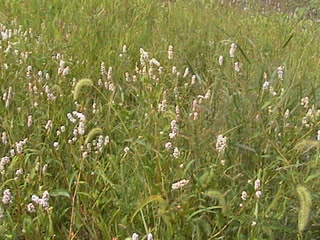|

Prairies
A prairie is "a complex
natural community covered with a dense mixture of tall grasses
and other herbaceous plants" (State of Indiana). Tall
grass prairies once stretched from Iowa and Missouri through
central Ohio, thus covering about 15 percent of Indiana's
landscape. Today, however, only small prairie remnants can
be found in northwestern
and west central
Indiana, in addition to very small, isolated remnants
in other parts of the state.
Grasslands survive in a climate
that is characterized by adequate yet erratic rainfall, bitterly
cold winters, and hot, dry summers. Tall grass, medium grass,
and short grass prairies are distinguished by the average
height of the grasses. For a tall grass prairie, they must
be at least waist high and may reach a range of six to eight
feet.
Several different types of prairie
exist, due to the differences in soil moisture and type. In
Indiana, rich black-soil and sand prairies were prevalent
in pre-settlement times. Although white settlers initially
believed prairies were virtually useless because of their
dense network of intertwined roots, they later discovered
the deep and nutrient-rich soil that lay just beneath the
surface. Due to the introduction of tools like steel plows,
the settlers were able to penetrate the extensive root systems
of prairies for agricultural
purposes.
Before the settlers came, Native
Americans would periodically burn the grass, which was a necessary
component of its regrowth process. These fires would prevent
the invasion of trees: "Hot fires killed tree seedlings
but not the prairie plants with their extensive underground
roots. Fire, in fact, tended to stimulate the growth of prairie
plants, which were quick to resprout following fire"
(State of Indiana).
Unfortunately,
of the original two million acres of virgin prairie grassland
in the state, less than one thousand acres survive today.
Many of the small remnant prairie tracts that remain in Indiana
are pioneer cemeteries and old railroad rights-of-way that
were never plowed (State of Indiana). The loss of prairie
land is particularly damaging since hundreds of plant species,
including goldenrod, big bluestem or turkey-foot grass, and
prairie dock, thrive there. Besides the abundant plant life,
creatures such as snakes and ground squirrels make their homes
in tall grass prairies. Two species that previously inhabited
prairie grasslands, the American bison and the prairie chicken,
became extinct in Indiana due to the massive destruction of
the habitat.
However, efforts have been made
to preserve what is left of this rich ecosystem. Some of Indiana's
prairie preservation attempts include Bill Barnes Nature Preserve,
located at the Willow Slough Fish and Wildlife Area near Morocco;
Gibson Woods Nature Preserve, located in Hammond,
and Hoosier Prairie Nature Preserve, which is located in
Lake County.
See also Preservation
and Conservation.
Sources:
Post, Thomas W. "Where Tallgrasses
Waved: The Grand Prairie Natural Region." The Natural
Heritage of Indiana. Ed. Marion T. Jackson. Bloomington:
Indiana UP, 1997. 189-94.
State of Indiana. Indiana Department
of Natural Resources. "An Indiana Prairie." Division
of Nature Preserves. 2002. 13 Nov. 2002 <www.state.in.us/dnr/naturepr/prairie.html>.
|




